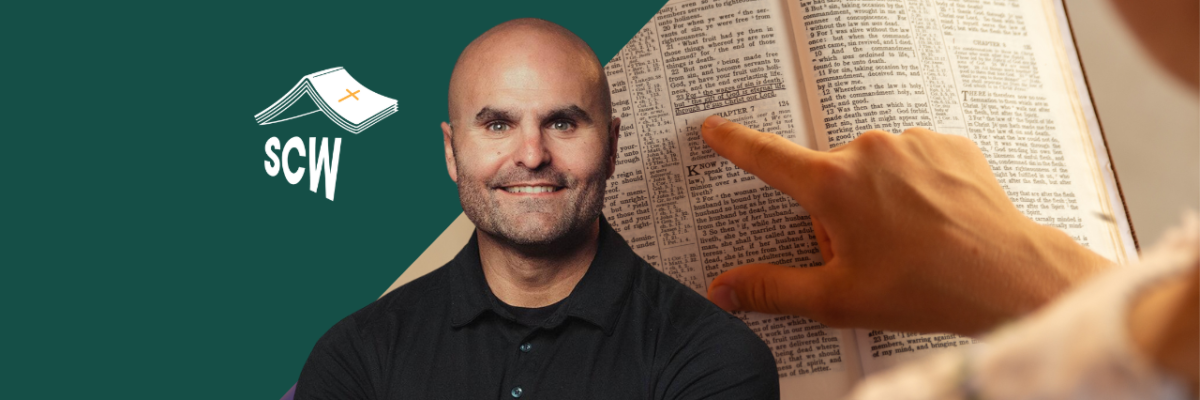
Episode 88: Year B – 17th Sunday of Ordinary Time
In this episode of the Sunday Catholic Word, we focus on two details, both of which come from the Gospel reading for this upcoming 17th Sunday of Ordinary Time, Year B, taken from John 6:1-15, which is John’s account of the feeding of the five thousand. One detail, Jesus’ question to Philip, gives rise to the topic of the historical reliability of John and Luke’s Gospels. The second detail, the fragments picked up after the crowd ate, pertains to the Eucharist.
Readings: Click Here
Looking for Sunday Catholic Word Merchandise? Look no further! Click Here
Hey everyone,
Welcome to The Sunday Catholic Word, a podcast where we reflect on the upcoming Sunday Mass readings and pick out the details that are relevant for explaining and defending our Catholic faith.
I’m Karlo Broussard, staff apologist and speaker for Catholic Answers, and the host for this podcast.
In this episode, we’re going to focus on two details, both of which come from the Gospel reading for this upcoming 17th Sunday of Ordinary Time, Year B, taken from John 6:1-15, John’s account of the feeding of the five thousand. One detail, Jesus’ question to Philip, gives rise to the topic of the historical reliability of John and Luke’s Gospels. The second detail, the fragments picked up after the crowd ate, pertains to the Eucharist.
Let’s get started. Here’s the whole passage:
Jesus went across the Sea of Galilee.
A large crowd followed him,
because they saw the signs he was performing on the sick.
Jesus went up on the mountain,
and there he sat down with his disciples.
The Jewish feast of Passover was near.
When Jesus raised his eyes
and saw that a large crowd was coming to him,
he said to Philip,
“Where can we buy enough food for them to eat?”
He said this to test him,
because he himself knew what he was going to do.
Philip answered him,
“Two hundred days’ wages worth of food would not be enough
for each of them to have a little.”
One of his disciples,
Andrew, the brother of Simon Peter, said to him,
“There is a boy here who has five barley loaves and two fish;
but what good are these for so many?”
Jesus said, “Have the people recline.”
Now there was a great deal of grass in that place.
So the men reclined, about five thousand in number.
Then Jesus took the loaves, gave thanks,
and distributed them to those who were reclining,
and also as much of the fish as they wanted.
When they had had their fill, he said to his disciples,
“Gather the fragments left over,
so that nothing will be wasted.”
So they collected them,
and filled twelve wicker baskets with fragments
from the five barley loaves
that had been more than they could eat.
When the people saw the sign he had done, they said,
“This is truly the Prophet, the one who is to come into the world.”
Since Jesus knew that they were going to come and carry him off
to make him king,
he withdrew again to the mountain alone.
As I mentioned, the first detail is Jesus’ question to Philip, “How are we to buy bread, so that these people may eat” (John 6:5). Philip responds in distress, telling Jesus, “two hundred denarii would not buy enough bread for each of them to get a little” (v.6).
What’s important for our purposes is that Jesus asks Philip. Why does he? You might think that Jesus would ask someone a little more important, like Peter, James, or John, rather than an apostle whose name is always listed among the second tier of apostles in Scripture (Matt. 10:2-4; Mark 3:13-19; Luke 6:12-16; Acts 1:13-14).
We find a clue at the beginning of Luke’s account of the same miracle, in chapter 9. Luke tells us that Jesus took the apostles and “withdrew apart to a city called Bethsaida” (v.10). This is important because according to John 1:43, “Philip was from Bethsaida, the city of Andrew and Peter.”
Being from Bethsaida, Philip would have had current local knowledge of where to buy bread. Thus, we have a plausible explanation for why Jesus asks Philip. Luke provides a piece of information that John lacks, but in an indirect way that doesn’t seem to be planned; hence an “undesigned coincidence.”
But someone may object, “Of course, John 1:43 tells us that Philip was from Bethsaida, but he also says that Andrew and Peter were from there as well. So why didn’t Jesus ask Peter or Andrew? They would have had the same local knowledge, right?”
This would be true only on the assumption that they were residents there at the time of the miracle. But we have evidence that they weren’t: they were residents in Capernaum. In Mark 1:21, we read about how Jesus, along with Simon, Andrew, James, and John, “went into Capernaum; and immediately on the sabbath . . . entered a synagogue and taught.” Then in verse 29, Mark tells us, “And immediately he left the synagogue, and entered the house of Simon and Andrew, with James and John.”
Peter and Andrew, therefore, although originally from Bethsaida, lived in Capernaum during the time of Jesus’s ministry. As such, they would not have had the current local knowledge of Bethsaida needed to know where to buy bread. But Philip did.
Now, why is this so important? Well, it supports the historical reliability of John and Luke’s Gospels. Luke’s account of the feeding of the five thousand provides a detail that explains why Jesus asks Philip where they can buy some bread in John’s account of the same event (John 6:5; Luke 9:10-12). And it’s not designed.
This sort of correlation is what nineteenth-century Anglican priest J.J. Blunt called “undesigned coincidences.” These occur when you have two texts that each contain pieces of information that fit together in a way that corroborate each other—without the authors having colluded to plant the information. The existence of such interlocking details in the Gospels suggests their veracity. They don’t corroborate each other in ways that you would expect if the authors were colluding. They’re not conspicuous verbatim agreements on the main facts, suggesting a conspiracy, but rather random details that fit together in subtle ways that may not be immediately apparent.
So many undesigned coincidences have been identified that a whole book can be written on them. Our Gospel reading for this upcoming Sunday gives us an opportunity to reflect on one of them.
There’s another detail in our Gospel reading that comes into play for another undesigned coincidence. It’s John’s remark about there being “much grass” within the context of John saying in verse 4, “the time of Passover was at hand.”
Mark provides us a detail in his account of this miracle that confirms the timing of the event, but seemingly without intention. In Mark 6:39, he states that the grass was “green.”
Why would Mark include this detail if he were fabricating this story? You’d think he would include some other detail to establish the timing, like, “It’s the time of the Passover.” But he doesn’t do this. The only explanation as to why Mark would include this detail is because he witnessed it, and the greenness of the grass made an impression on him. Also, Mark wrote before John, so it’s not like he’s trying to intentionally confirm what John writes.
Now, the third detail is John’s report that the apostles picked up “fragments from the five barely loaves.” Notice it doesn’t say that picked up baskets of the multiple loaves that Jesus multiplied or created. Rather, they picked up fragments from the five loaves.
To flesh this out a bit, Jesus didn’t create a sixth loaf, a seventh loaf, an eighth loaf, etc. Rather, the thousands were fed with the five loaves. So, as Peter started to break pieces off of his loaf, the quantity of the bread remained the same, or at least enough for him to continue breaking pieces off to feed however many he fed.
And the same occurred for the other apostles handed out the remaining four loaves. As they broke pieces off of their loaves, the quantity of their loaves would have also remained the same, or at least remained such that they could continue to break pieces off and feed the multitudes.
What this reveals is God’s power to preserve in being the accidental properties of bread, which in this case is quantity. As a Catholic, you can see where I’m going with this.
This event tees up Jesus’ Bread of Life Discourse in which he first promises to give us the bread from heaven which is his flesh, fulfilled at the Last Supper in the Eucharist. The lesson is that just as God can preserve in being the quantity of bread, he can preserve in being the quantity of the bread at the Last Supper, the look of the bread, the taste of the bread, and it not be bread. The miracle of the loaves is meant to prepare us for the revelation of the Sacrament of the Eucharist.
Conclusion
Well, my friends, that does it for this episode of the Sunday Catholic Word. The Gospel for this upcoming 17th Sunday of Ordinary Time, Year B, provides us with some great details that are relevant for doing apologetics:
- Establishing a general trustworthiness of the Gospels, and
- The Eucharist.
As always, thank you for subscribing to the podcast. And please be sure to tell your friends about it and invite them to subscribe as well at sundaycatholicword.com. You might also want to check out the other great podcasts in our Catholic Answers podcast network: Cy Kellet’s Catholic Answers Focus, Trent Horn’s The Counsel of Trent, Joe Heschmeyer’s Shameless Popery, and Jimmy Akin’s A Daily Defense, all of which can be found at catholic.com.
One last thing: if you’re interested in getting some cool mugs and stickers with my logo, “Mr. Sunday podcast,” go to shop.catholic.com.
I hope you have a blessed 17th Sunday of Ordinary Time, Year B. Until next time, God Bless!



